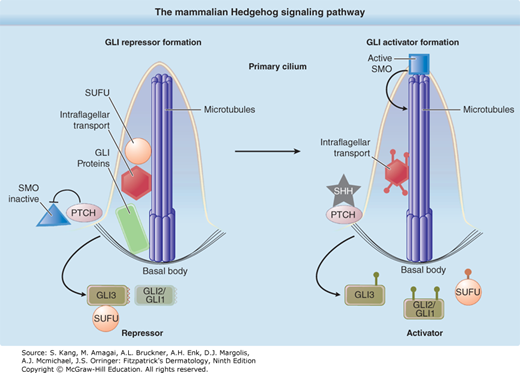Dermatology Question of the Week: Surgical Skills

A 40-year-old patient presents with numerous lesions on his face, back, arms, and legs and a longstanding history of little spots on his hands. Examples of both of these types of lesions are pictured below.


He has had multiple of these spots treated since his teenage years and his sister has had similar lesions as well as a brain tumor as a child. The patient wants to explore non-surgical options and would like try an oral option if there is one available. Which of the following is the correct mechanism of action for an oral medication used to treat this condition?
A. Binds to toll-like receptors 7 and 8 inducing cytokine production
B. Inhibits thymidylate synthase
C. Binds to Smoothened
D. Binds to SUFU
Rationale: The patient in the vignette has multiple basal cell carcinomas and palmar pits, a family history of similar genetic disorder, and a sister with medulloblastoma as a child. This combination of features is suggestive of basal cell nevus syndrome. The diagnostic criteria are listed in the table below.
Table 111-4 Diagnostic Criteria for Basal Cell Nevus Syndrome (BCNS, Gorlin Syndrome)
|
Major Criteria
|
|
Minor Criteria
|
The hedgehog signalling pathway is disrupted in patients with basal cell nevus syndrome leading to unregulated growth and proliferation. The normal pathway is shown in the figure below.

Correct answer:
C. Binds to Smoothened
Vismodegib is a Smoothened inhibitor used for the treatment of locally advanced, metastatic, or inoperable basal cell carcinomas and can be a good option in patients with basal cell nevus syndrome as patients with basal cell nevus syndrome frequently have a mutation in PTCH. PTCH normally inhibits Smoothened and prevents downstream proliferation and differentiation.
Incorrect answers:
A. Binds to toll-like receptors 7 and 8 inducing cytokine production
This is the mechanism of action of Imiquimod which can be used topically for superficial basal cell carcinomas.
B. Inhibits thymidylate synthase
This is the mechanism of action of 5-fluorouracil which is approved for the topical treatment of superficial basal cell carcinoma and actinic keratoses.
D. Binds to SUFU
Sufu is downstream from Smoothened and can be the primary mutation in basal cell nevus syndrome or a secondary mutation within a specific tumor. Currently, there are no available SUFU inhibitors although this is being studied.
Additional reading at Chapter 111: Basal Cell Carcinoma and Basal Cell Nevus Syndrome

Create a Free MyAccess Profile
AccessMedicine Network is the place to keep up on new releases for the Access products, get short form didactic content, read up on practice impacting highlights, and watch video featuring authors of your favorite books in medicine. Create a MyAccess profile and follow our contributors to stay informed via email updates.